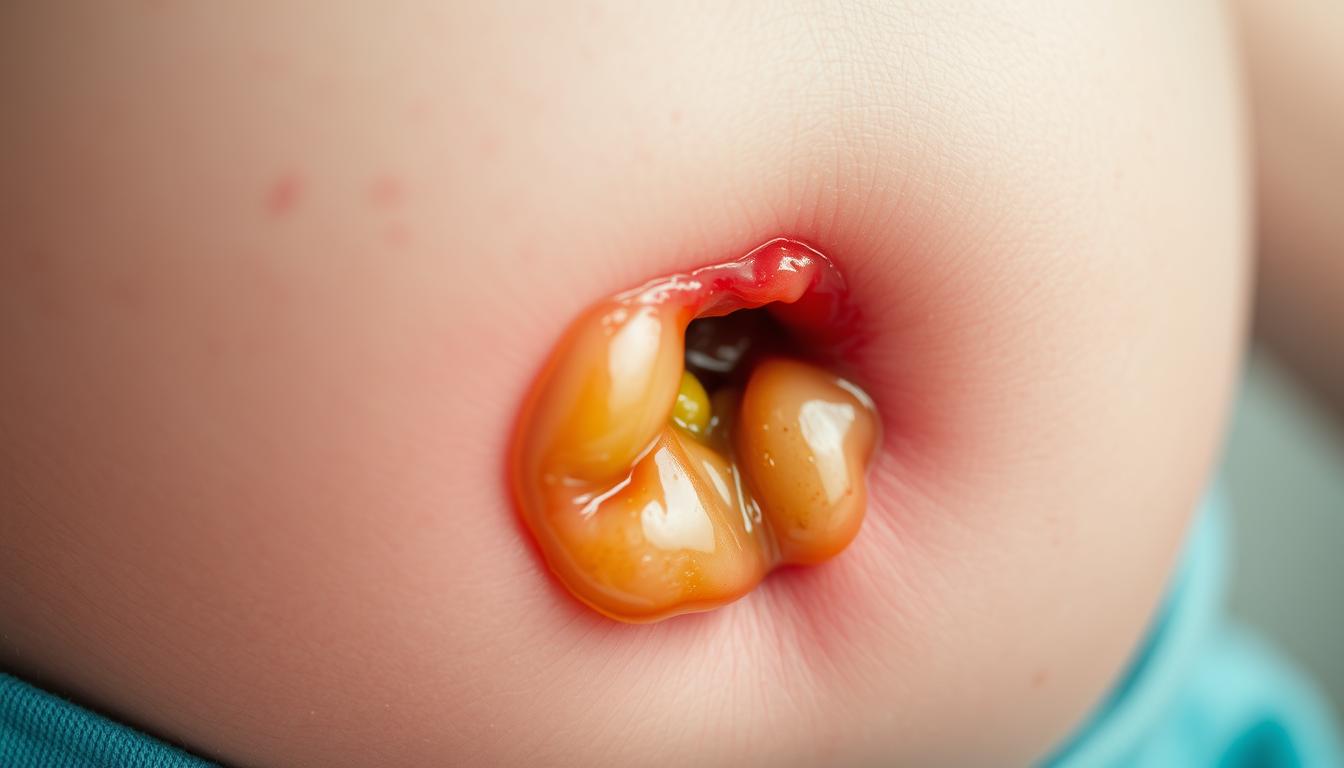
Have you ever thought about dangers in unexpected places on your body? Umbilical infections might not be the first thing you think of. But they can be serious.
While it’s rare for a belly button infection to be deadly, it’s important to know the risks. This is true if you have a weak immune system. Most infections in this area can be treated with good hygiene and medicine.
But ignoring the problem can lead to bigger issues.
Key Takeaways
- Belly button infections are rarely life-threatening but can be serious if left untreated.
- Proper hygiene and medication are key to treating umbilical infections.
- Individuals with weakened immune systems are at higher risk of complications.
- Understanding the risks and taking preventive measures is important.
- Prompt treatment can significantly reduce the risk of severe outcomes.
Understanding Belly Button Infections
It’s important to know what causes belly button infections to prevent and treat them early. These infections happen when bacteria or fungi get into the navel skin. Poor hygiene, ingrown hairs, or allergic reactions to jewelry are common reasons.
Common Causes of Infections
Many things can lead to belly button infections. Poor hygiene is a big risk because it lets bacteria and fungi grow in the navel’s warm, moist space. Ingrown hairs can also cause infections if not taken care of properly. Allergic reactions to jewelry or other objects touching the belly button can irritate the skin and raise infection risk.
Health experts say, “Keeping good hygiene is essential to avoid infections” (Sesame Care). This highlights the need for regular cleaning and proper belly button care.
Risk Factors to Consider
Some people are more likely to get belly button infections because of certain risk factors. Those with diabetes or who are obese might face a higher risk. This is because these conditions can slow healing and make infections more likely. Also, people with piercings in their navel are at risk if the piercing isn’t cared for properly, as it can introduce bacteria.
Knowing these risk factors and taking steps to prevent infections is key. Regular checks and good hygiene practices are important for staying infection-free.
Symptoms of a Belly Button Infection
Knowing the signs of a belly button infection is key to avoiding bigger problems. Spotting symptoms early lets you get medical help fast. This can stop more serious issues from happening.
Recognizing Early Signs
The signs of a belly button infection can differ. But, common ones include redness or swelling around the belly button, pain or tenderness, and discharge. You might also feel itching or have a fever. These signs mean an infection might be there and needs care.
If you see any of these signs, watch them closely. For more info, check out our resource page.
| Symptom | Description | Implication |
|---|---|---|
| Redness or Swelling | Visible inflammation around the belly button | Possible infection or irritation |
| Pain or Tenderness | Soreness when touched or pressed | Infection or abscess formation |
| Discharge | Presence of pus or fluid | Active infection requiring medical attention |
When to Seek Medical Attention
If you see any of these, it’s time to seek medical help:
- Increasing redness or swelling
- Severe pain
- Fever or chills
- Pus or discharge
Getting help early can stop the infection from getting worse. If you’re not sure about your symptoms, it’s best to talk to a doctor.
How a Belly Button Infection Develops
Belly button infections can come from poor hygiene. The belly button is warm and moist, perfect for bacteria and fungi to grow. This is why regular cleaning is key.
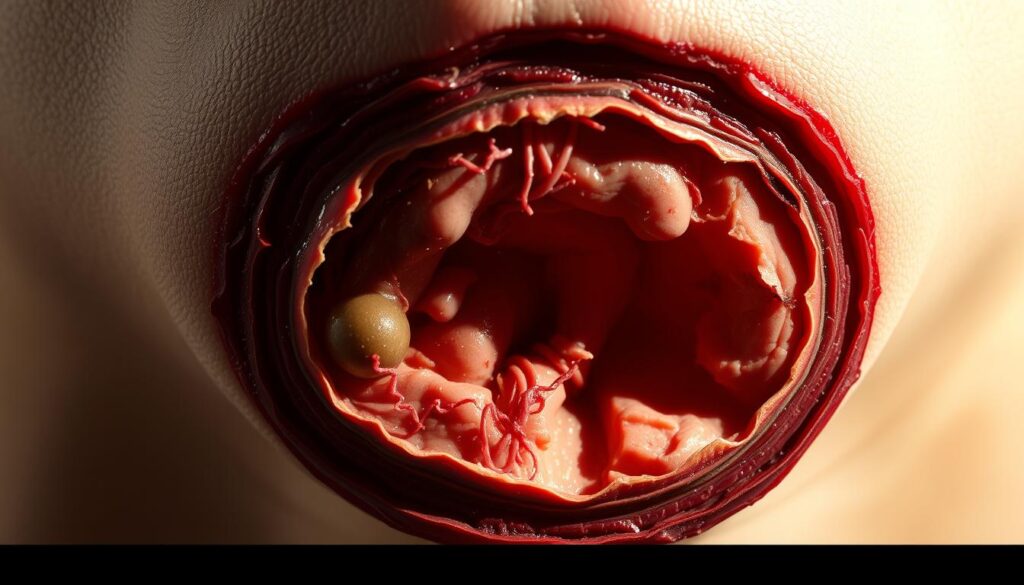
The Role of Hygiene
Good hygiene is vital to avoid belly button infections. Clean your belly button every day, more often if you’ve been sweating a lot. Use mild soap and water, and make sure to dry it well.
Tips for Good Hygiene:
- Clean your belly button daily with mild soap and water.
- Dry your belly button thoroughly after washing.
- Avoid using harsh or abrasive cleansers that can irritate the skin.
Impact of Body Piercings
Body piercings, like those in the navel, can raise infection risks if not cared for right. Always follow your piercer’s aftercare advice to avoid problems.
Caring for Your Piercing:
- Soak the piercing in a saline solution 2-3 times a day.
- Avoid tight clothing that can irritate the piercing.
- Keep your hands away from the piercing to prevent introducing bacteria.
Knowing what causes belly button infections and keeping up with hygiene and piercing care can lower your infection risk. This way, you can enjoy your belly button without worrying about infections.
Complications of Untreated Infections
Untreated belly button infections can cause serious problems beyond the navel area. Bacteria or fungi in the belly button can lead to various issues if not treated quickly.
Potential for Systemic Infection
One major risk is the infection spreading through the bloodstream. This can lead to sepsis, a serious condition that can be life-threatening. People with weak immune systems are more at risk.
Other Health Issues
Untreated infections can also cause other health problems. They can make daily activities painful and uncomfortable. In some cases, they may even form abscesses or cysts that need surgery.
Ignoring an infection can lead to scarring and long-term skin issues. It’s important to get medical help if you think you have an infection. Early treatment can prevent serious health problems.
Diagnosis of a Belly Button Infection
Diagnosing a belly button infection involves a physical check-up and tests. When you see a doctor with belly button infection symptoms, they’ll start with a detailed look.
Physical Examination
The doctor will examine your belly button and the area around it. They look for signs like redness, swelling, or discharge. They also check for tenderness or pain.
The examination is key to figure out how serious the infection is. It helps find out if a piercing or poor hygiene is the cause.
Diagnostic Tests
At times, the doctor might need to run tests to find the infection’s cause or any underlying issues.
These tests could be:
- A swab of the infected area to check for bacteria or fungi
- Blood tests to check for signs of infection or inflammation
- Imaging tests, such as an ultrasound or CT scan, to check for any abscesses or other complications
It’s vital to do the tests the doctor suggests. This ensures you get the right treatment.
By using the findings from the physical check-up and tests, doctors can decide the best treatment for your belly button infection.
Treatment Options for Belly Button Infections
Dealing with a belly button infection? Knowing your treatment options is key. You might need home care and medical treatments like antibiotics or antifungal meds. This depends on what’s causing the infection.
Home Care Remedies
For mild infections, home care is often the first step. Here are some ways to help manage symptoms and aid in healing:
- Keep the belly button area clean and dry.
- Use an antibacterial soap or a saline solution to clean the area.
- Apply an over-the-counter antibiotic ointment.
- Avoid tight clothing that can irritate the area.
Table: Home Care Remedies for Belly Button Infections
| Remedy | Description | Benefits |
|---|---|---|
| Antibacterial Soap | Use soap that contains antibacterial agents. | Reduces bacterial growth. |
| Saline Solution | Mix salt with warm water to create a saline solution. | Helps to clean and reduce swelling. |
| Antibiotic Ointment | Apply over-the-counter antibiotic ointment. | Promotes healing and reduces infection. |
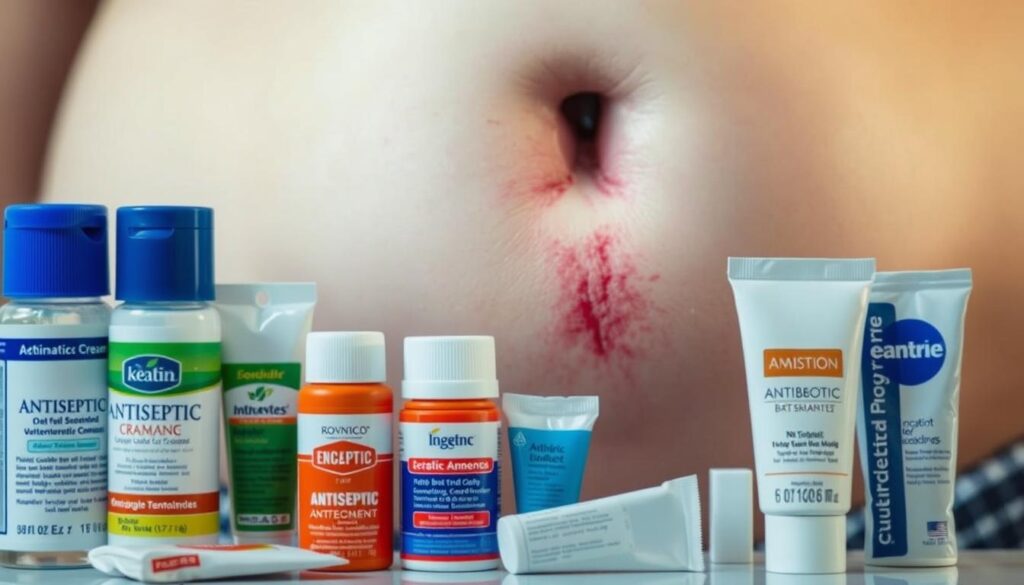
Antibiotics and Medication
If your infection is serious or doesn’t get better with home care, your doctor might give you antibiotics or antifungal meds. It’s important to stick to the treatment plan to clear the infection.
Types of Antibiotics:
- Oral antibiotics for more severe infections.
- Topical antibiotics for localized infections.
It’s vital to finish all antibiotics as directed. This helps prevent the infection from coming back and stops antibiotic resistance.
Preventing Belly Button Infections
You can lower the chance of getting belly button infections by following easy care tips. Keeping your area clean is key, even more so if you have a piercing.
Importance of Good Hygiene
Good hygiene is key to avoiding belly button infections. Clean your belly button with soap and water often. Make sure to dry it well after you shower or bathe to stop bacteria from growing.
- Clean your belly button every day.
- Use a saline solution for cleaning if you have a piercing.
- Stay away from harsh soaps that can upset your skin.
Dr. Emily Chen, a dermatologist, says, “Keeping your belly button clean is a simple yet effective way to prevent infections.”
“Hygiene is the cornerstone of prevention when it comes to belly button infections.”
Tips for Body Piercing Care
If you have a belly button piercing, taking good care of it is important to avoid infection. Here’s what to do:
- Soak the piercing in a saline solution every day.
- Stay away from tight clothes that can bother the piercing.
- Don’t mess with the piercing, as this can bring in bacteria.
| Care Tips | Benefits |
|---|---|
| Daily saline soak | Reduces bacterial growth |
| Avoiding tight clothing | Minimizes irritation |
| Not playing with the piercing | Prevents introducing bacteria |
By following these simple tips, you can greatly lower your risk of getting a belly button infection. Remember, good hygiene and proper care for piercings are essential for your health.
When Can a Belly Button Infection Be Dangerous?
A belly button infection can turn serious if it becomes a severe infection or sepsis. This is more likely in people with weak immune systems.
Signs of Severe Infection
Look out for increased redness and swelling around the navel. Also, watch for pus or discharge and a high fever. If you see these signs, get medical help right away.
Other signs of a severe infection include:
- Increased pain or tenderness around the belly button
- Foul odor from the navel area
- Red streaks leading from the infected area
Understanding Sepsis
Sepsis is a dangerous condition where the body’s response to an infection gets out of control. It can be fatal. Spotting sepsis early is key to treating it effectively.
Common symptoms of sepsis are:
| Symptom | Description |
|---|---|
| High fever | Temperature above 101.5°F (38.6°C) |
| Rapid heart rate | Heart beating more than 90 times per minute |
| Rapid breathing rate | More than 20 breaths per minute |
| Confusion or disorientation | Feeling confused or having trouble thinking clearly |
Acting fast can save lives. If you’re diagnosed with sepsis, you’ll get antibiotics and supportive care in the hospital.
Myths About Belly Button Infections
Knowing the truth about belly button infections can keep you healthy. Many people believe wrong things about these infections. This can cause them to wait too long or treat them wrong.
Common Misconceptions
Some think belly button infections are rare and not serious. But, they can happen often, mainly to those with poor hygiene or piercings.
Others believe only pierced people get these infections. But, anyone can get them because of sweat, tight clothes, or bad belly button care.
- Myth: Belly button infections are always painful. Fact: Some infections may not hurt much at first.
- Myth: Only unclean people get belly button infections. Fact: Clean people can get them too, because of other reasons.
Facts to Keep in Mind
Knowing the real facts about belly button infections is key. Here are some important ones:
- Belly button infections can be caused by bacteria, fungi, or yeast.
- Poor hygiene, tight clothes, and too much sweat can lead to infections.
- Body piercings raise the risk, but good care can lower it.
By understanding these facts and myths, you can better take care of your belly button. This will help lower the chance of getting infections.
The Importance of Follow-Up Care
Follow-up care is key after a belly button infection. It makes sure the infection is gone and there are no more problems.
Ensuring Complete Healing
To heal fully, you should:
- Go to all follow-up doctor’s appointments.
- Watch your symptoms and tell your doctor about any changes.
- Keep the belly button clean and dry, as your doctor suggests.
Complete healing means the infection is gone, and you’re less likely to get it again. Your doctor might check you during these visits to make sure.
Recognizing Recurrence
It’s important to spot signs of recurrence early. If you see:
- More redness or swelling around the belly button.
- Pus or discharge from the belly button.
- Fever or chills.
- A bad smell from the belly button area.
Early detection helps treat it quickly, avoiding bigger problems. If you’ve had this before, watch for these signs closely.
By following these steps and staying alert, you can recover fully and avoid future infections.
How Lifestyle Affects Infection Risk
Your lifestyle, including diet and stress, greatly affects your risk of getting belly button infections. A healthy lifestyle boosts your immune system and lowers infection risk.
Diet and Nutritional Support
Eating a balanced diet full of nutrients is key for a strong immune system. Foods like fruits and veggies, rich in antioxidants, fight infections. Drinking lots of water is also important for your health.
Nutritional Tips:
- Eat foods high in vitamin C, like oranges and strawberries, to boost your immune system.
- Include zinc-rich foods, such as chicken and beans, to support wound healing.
- Avoid too much sugar and processed foods, as they can weaken your immune system.
Managing Stress and Health
High stress can weaken your immune system, making you more likely to get infections. Doing things that reduce stress can help.
Stress Management Techniques:
- Try mindfulness and meditation to lower stress.
- Do regular physical activities like walking or yoga to improve your health.
- Make sure to get enough sleep each night to help your body heal.
By choosing a healthy lifestyle, you can lower your risk of belly button infections. Eating well and managing stress are important for a strong immune system.
Home Remedies vs. Professional Treatment
Choosing between home remedies and a doctor for a belly button infection depends on several factors. Some infections are mild and can be treated at home. But, others need medical help to avoid serious problems.
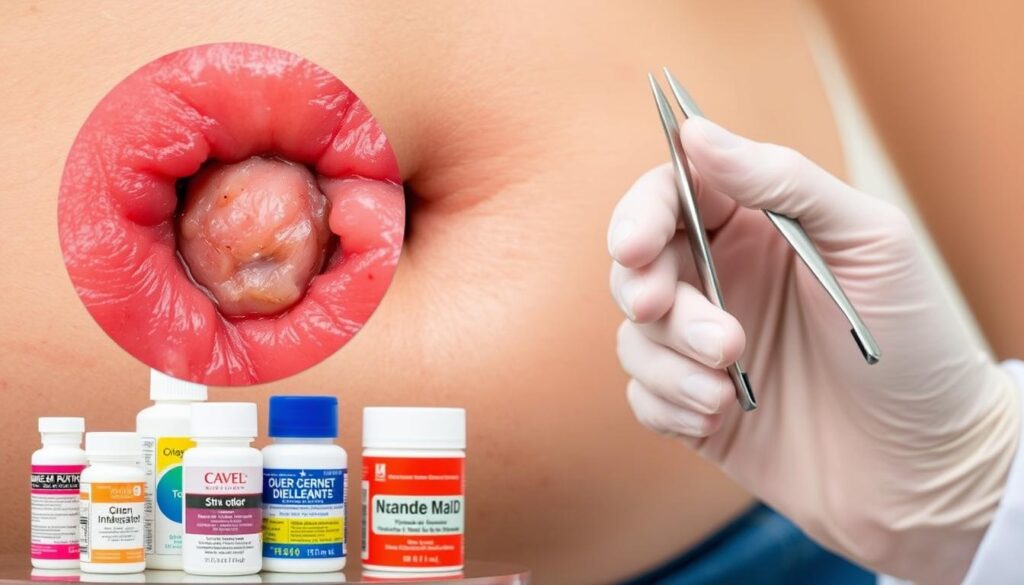
Pros and Cons of Self-Treatment
Home remedies can help with mild belly button infections. Keeping the area clean and using an antibiotic ointment can prevent it from getting worse. But, if the infection is severe or doesn’t get better, you might need to see a doctor.
Self-treatment is convenient and can save money. It lets you handle mild symptoms at home. But, it can lead to misdiagnosis, worsening of the infection, and slower recovery. It’s important to consider these points when deciding what to do.
When to Consult a Doctor
It’s key to know when to see a doctor for a belly button infection. If you notice more redness, swelling, or pain, it could mean the infection is getting worse. Also, if you have a fever, pus, or a bad smell, you should get medical help. These signs mean you might need professional medical care to avoid serious health issues.
People with health conditions like diabetes or a weak immune system should be extra careful. They should see a doctor sooner. Knowing when to seek medical help can help you manage belly button infections better.
In summary, home remedies are good for mild infections, but sometimes you need a doctor. Understanding the benefits and drawbacks of self-treatment and knowing when to see a doctor can help you handle belly button infections effectively.
FAQs About Belly Button Infections
Wondering about belly button infections? You’re not alone. Many people have questions about them, from causes to prevention and treatment.
Can Anyone Get an Infection?
Belly button infections can happen to anyone, no matter their age or how clean they are. But some things can make you more likely to get one. These include a deep navel, body piercings, poor hygiene, and tight clothes.
The belly button is a perfect spot for bacteria and fungi to grow. Keeping it clean and dry is key to avoiding infections.
What Should You Not Do?
When you have a belly button infection, there are things you should not do. Don’t try to treat it yourself without a doctor’s advice. This can make things worse. Also, stay away from harsh chemicals or rough cleaners, as they can irritate the skin.
- Avoid tight clothing that can irritate the belly button area.
- Refrain from sharing personal care items to prevent the spread of infection.
- Don’t ignore the signs of infection, such as redness, swelling, or discharge.
Knowing these things and taking steps to prevent infections can help a lot. This way, you can lower your chances of getting a belly button infection.
Recognizing the Right Time to Visit a Doctor
It’s important to know when to see a doctor for belly button infections. If your symptoms get worse or don’t get better with home care, it’s time to go to a healthcare professional.
Signs That Warrant Immediate Attention
Some signs mean you need to see a doctor right away. These include:
- Increasing redness and swelling around the navel
- Pus or discharge that is thick, yellow, or green
- A foul odor from the belly button area
- Severe pain or tenderness
- Fever or chills
If you see any of these signs, go to the doctor quickly. For more info on belly button infections, check out MedicineNet’s Belly Button Infection Article.
Advantages of Early Treatment
Early treatment of belly button infections has many benefits. These include:
| Benefits | Description |
|---|---|
| Reduced Risk of Complications | Prompt treatment can prevent the infection from spreading and causing more severe health issues. |
| Faster Recovery | Early intervention typically results in quicker healing times and less discomfort. |
| Less Aggressive Treatment | Early treatment may avoid the need for more aggressive interventions, such as surgery or strong antibiotics. |
By recognizing the signs that warrant immediate attention and understanding the advantages of early treatment, you can take proactive steps to manage belly button infections effectively.
The Connection Between Hygiene and Health
Knowing how important hygiene is can help you avoid belly button infections. It also keeps you healthy overall. Good hygiene stops bacteria and pathogens from building up, which can cause infections.
Why Cleanliness Matters
Cleanliness is key to keeping your body healthy. It lowers the chance of getting infections, even in sensitive spots like the belly button. For example, keeping your belly button clean and dry stops sweat and bacteria buildup, which can cause infections.
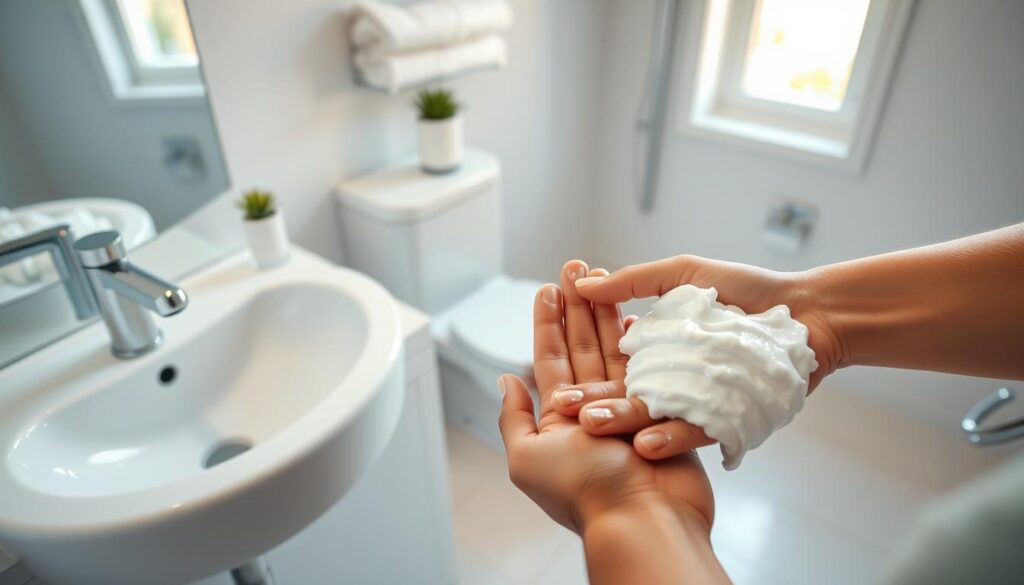
Establishing a Healthy Routine
To keep good hygiene and avoid belly button infections, follow these easy steps:
- Clean your belly button every day with soap and water.
- Dry your belly button well after showering or bathing.
- Stay away from harsh chemicals or rough materials that can hurt your skin.
- Think about using antibacterial soap to lower infection risk even more.
Adding these habits to your daily routine can greatly lower belly button infection risk. It also helps your overall health and well-being.
Living with a Belly Button Infection
Dealing with a belly button infection can be tough, but you can get through it. The right strategies and resources can help a lot. Remember, many people have beaten similar infections.
Coping Strategies
Keeping the area clean is key. Use soap and water to gently clean it, then dry it well. Wearing loose, comfy clothes can also help avoid irritation.
Support and Resources
If you’re finding it hard, talk to healthcare experts or look online. Sites like the Centers for Disease Control and Prevention (CDC) and the American Academy of Dermatology have great info. They talk about skin infections and how to stay clean.
Using these tips and resources can help you manage your infection. It also helps prevent it from coming back.
